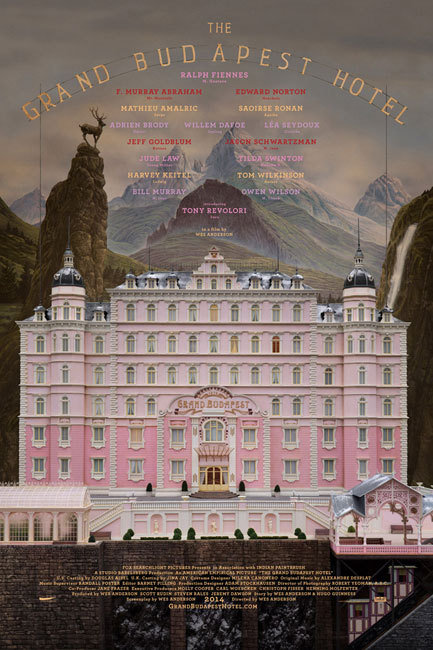 Fox Searchlight
Fox Searchlight
Much as he did with Moonrise Kingdom, Wes Anderson managed to make his next film, The Grand Budapest Hotel, without revealing a great dea; about the plot, characters, or accruing much hype at all. Sure, if you wanted to, you could find out that it’s about the concierge, played by Ralph Fiennes, of a stately Hungarian hotel during the 1920s as he struggles to manage the issues of his guests, from art heists to mixed-up family fortunes (a familiar theme) and the young protegee he teaches (and, presumably, learns from) throughout. It’s a mash-up of all his previous films in a way only Anderson could make exciting. Even the smallest change — say, setting the film in the ’20s instead of the ’60s/’70s — is a seismic one.
For a hard-core Anderson fan, there’s a lot to take apart in this poster. First, the whole cast. Of course, there are repeat players, such as Bill Murray, Jason Schwartzman, Adrian Brody, and Owen Wilson. Occasional players are also back for seconds, like Tilda Swinton and Edward Norton, returning after the success of Moonrise Kingdom. Surprisingly, this film was written solely by Anderson, who has always had a collaborator (most often Wilson or Roman Coppola, but also Noah Baumbach) on his last eight films.
Most of the poster is the hotel itself. It’s enormous enough to be outfitted with plenty of oddities, specialized rooms, and secret passageways. It’s grand enough to hear plenty of tales about famous guests (a few kings or queens, perhaps) but also looks new enough that the guests will be rich and demanding. In the background, there are soaring mountain views. Perched on the top of a peak is a stag, who should no doubt be either a symbol or a piece of the plot in this film.
Another suprise is the bold use of pink. Obviously the titular hotel had to be quirky, but pink is not only a bold choice, but an uncharacteristic color for a Wes Anderson film. Usually, Anderson works with yellows and browns, or, in The Life Aquatic and Rushmore, with blue. The color scheme of these films can suggest themes or ideas (the earthiness of Fantastic Mr. Fox, or the sepia nostalgia of The Royal Tenenbaums), but pink is bright, cheery, hardly what comes to mind when hearing “Post WWI Europe.” Maybe this hotel will be a tiny pocket of Roaring ’20s in a country ravaged by the war. Anderson often writes about privileged, overgrown rich kids who are forced to grow up (just look at The Darjeeling Limited).
Now it’s time to excitedly wait for either a trailer or the official soundtrack — the only two things that could tell us more.


